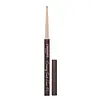What's inside
What's inside
 Key Ingredients
Key Ingredients

 Benefits
Benefits

No benefits
 Concerns
Concerns

 Ingredients Side-by-side
Ingredients Side-by-side

Cyclopentasiloxane
EmollientTrimethylsiloxysilicate
EmollientCI 77499
Cosmetic ColorantSynthetic Wax
AbrasiveCI 77491
Cosmetic ColorantSilica
AbrasiveTrimethylsiloxysilicate/Dimethiconol Crosspolymer
Mica
Cosmetic ColorantSilica Silylate
EmollientMangifera Indica Seed Oil
EmollientCI 77492
Cosmetic ColorantCI 77510
Cosmetic ColorantPentaerythrityl Tetra-Di-T-Butyl Hydroxyhydrocinnamate
AntioxidantCyclohexasiloxane
EmollientCopernicia Cerifera Cera
EmollientCyclopentasiloxane, Trimethylsiloxysilicate, CI 77499, Synthetic Wax, CI 77491, Silica, Trimethylsiloxysilicate/Dimethiconol Crosspolymer, Mica, Silica Silylate, Mangifera Indica Seed Oil, CI 77492, CI 77510, Pentaerythrityl Tetra-Di-T-Butyl Hydroxyhydrocinnamate, Cyclohexasiloxane, Copernicia Cerifera Cera
Methyl Trimethicone
Skin ConditioningTrimethylsiloxysilicate
EmollientAcrylates/Stearyl Acrylate/Dimethicone Methacrylate Copolymer
Polyethylene
AbrasiveCopernicia Cerifera Wax
Euphorbia Cerifera Wax
Dimethicone
EmollientHydrogenated Lecithin
EmulsifyingSilica
AbrasiveMethyl Methacrylate Crosspolymer
Tocopherol
AntioxidantSimmondsia Chinensis Seed Oil
EmollientSqualane
EmollientMacadamia Ternifolia Seed Oil
EmollientMethicone
EmollientSodium Hyaluronate
HumectantAluminum Hydroxide
EmollientBHT
AntioxidantCI 77491
Cosmetic ColorantCI 77492
Cosmetic ColorantCI 77499
Cosmetic ColorantMica
Cosmetic ColorantCI 77891
Cosmetic ColorantMethyl Trimethicone, Trimethylsiloxysilicate, Acrylates/Stearyl Acrylate/Dimethicone Methacrylate Copolymer, Polyethylene, Copernicia Cerifera Wax, Euphorbia Cerifera Wax, Dimethicone, Hydrogenated Lecithin, Silica, Methyl Methacrylate Crosspolymer, Tocopherol, Simmondsia Chinensis Seed Oil, Squalane, Macadamia Ternifolia Seed Oil, Methicone, Sodium Hyaluronate, Aluminum Hydroxide, BHT, CI 77491, CI 77492, CI 77499, Mica, CI 77891
 Reviews
Reviews

Ingredients Explained
These ingredients are found in both products.
Ingredients higher up in an ingredient list are typically present in a larger amount.
Ci 77491 is also hydrated iron III oxide. It's sole purpose is to give a red/pink hue to products.
Iron III oxides are classified as inorganic chemicals for coloring.
Synthetically created Ci 77491 is considered safer than those naturally found. This is because the synthetically created version may contain less impurities. Iron oxides are generally non-toxic and non-allergenic.
Learn more about CI 77491Ci 77492 is also hydrated iron III oxide. It's sole purpose is to give a yellow hue to products.
Iron III oxides are classified as inorganic chemicals for coloring.
Synthetically created Ci 77492 is considered safer than those naturally found. This is because the synthetically created version may contain less impurities. Iron oxides are generally non-toxic and non-allergenic.
Learn more about CI 77492Ci 77499 is also hydrated iron III oxide. It is created from mixing red and black iron oxides. This helps give shades of darkness to a product.
Iron III oxides are classified as inorganic chemicals for coloring.
Mica is a naturally occurring mineral used to add shimmer and color in cosmetics. It can also help improve the texture of a product or give it an opaque, white/silver color.
Serecite is the name for very fine but ragged grains of mica.
This ingredient is often coated with metal oxides like titanium dioxide. Trace amounts of heavy metals may be found in mica, but these metals are not harmful in our personal products.
Mica has been used since prehistoric times throughout the world. Ancient Egyptian, Indian, Greek, Roman, Aztec, and Chinese civilizations have used mica.
Learn more about MicaSilica, also known as silicon dioxide, is a naturally occurring mineral. It is used as a fine, spherical, and porous powder in cosmetics.
Though it has exfoliant properties, the function of silica varies depending on the product.
The unique structure of silica enhances the spreadability and adds smoothness, making it a great texture enhancer.
It is also used as an active carrier, emulsifier, and mattifier due to its ability to absorb excess oil.
In some products, tiny microneedles called spicules are made from silica or hydrolyzed sponge. When you rub them in, they lightly polish away dead skin layers and enhance the penetration of active ingredients.
Learn more about SilicaThis silicone is an emollient. Emollients create a thin film on the skin to prevent moisture from escaping.
It is not soluble in water and helps increase water-resistance in products.
According to a manufacturer, it can blend seamlessly with silicone oils, such as Cyclopentasiloxane.
Learn more about Trimethylsiloxysilicate